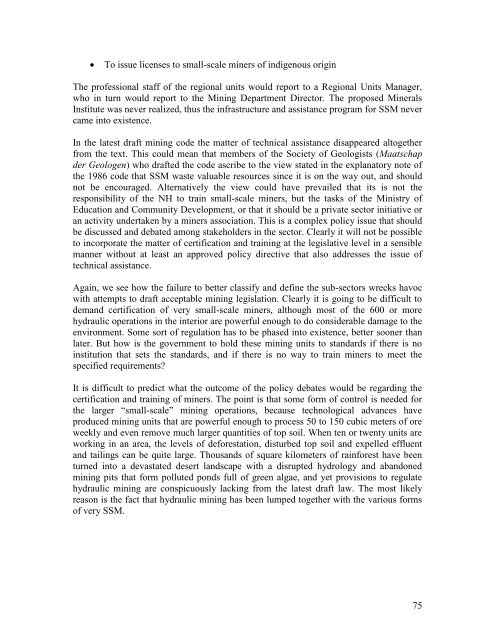SITUATION ANALYSIS OF THE SMALL-SCALE GOLD ... - WWF
SITUATION ANALYSIS OF THE SMALL-SCALE GOLD ... - WWF
SITUATION ANALYSIS OF THE SMALL-SCALE GOLD ... - WWF
You also want an ePaper? Increase the reach of your titles
YUMPU automatically turns print PDFs into web optimized ePapers that Google loves.
To issue licenses to small-scale miners of indigenous origin<br />
The professional staff of the regional units would report to a Regional Units Manager,<br />
who in turn would report to the Mining Department Director. The proposed Minerals<br />
Institute was never realized, thus the infrastructure and assistance program for SSM never<br />
came into existence.<br />
In the latest draft mining code the matter of technical assistance disappeared altogether<br />
from the text. This could mean that members of the Society of Geologists (Maatschap<br />
der Geologen) who drafted the code ascribe to the view stated in the explanatory note of<br />
the 1986 code that SSM waste valuable resources since it is on the way out, and should<br />
not be encouraged. Alternatively the view could have prevailed that its is not the<br />
responsibility of the NH to train small-scale miners, but the tasks of the Ministry of<br />
Education and Community Development, or that it should be a private sector initiative or<br />
an activity undertaken by a miners association. This is a complex policy issue that should<br />
be discussed and debated among stakeholders in the sector. Clearly it will not be possible<br />
to incorporate the matter of certification and training at the legislative level in a sensible<br />
manner without at least an approved policy directive that also addresses the issue of<br />
technical assistance.<br />
Again, we see how the failure to better classify and define the sub-sectors wrecks havoc<br />
with attempts to draft acceptable mining legislation. Clearly it is going to be difficult to<br />
demand certification of very small-scale miners, although most of the 600 or more<br />
hydraulic operations in the interior are powerful enough to do considerable damage to the<br />
environment. Some sort of regulation has to be phased into existence, better sooner than<br />
later. But how is the government to hold these mining units to standards if there is no<br />
institution that sets the standards, and if there is no way to train miners to meet the<br />
specified requirements?<br />
It is difficult to predict what the outcome of the policy debates would be regarding the<br />
certification and training of miners. The point is that some form of control is needed for<br />
the larger “small-scale” mining operations, because technological advances have<br />
produced mining units that are powerful enough to process 50 to 150 cubic meters of ore<br />
weekly and even remove much larger quantities of top soil. When ten or twenty units are<br />
working in an area, the levels of deforestation, disturbed top soil and expelled effluent<br />
and tailings can be quite large. Thousands of square kilometers of rainforest have been<br />
turned into a devastated desert landscape with a disrupted hydrology and abandoned<br />
mining pits that form polluted ponds full of green algae, and yet provisions to regulate<br />
hydraulic mining are conspicuously lacking from the latest draft law. The most likely<br />
reason is the fact that hydraulic mining has been lumped together with the various forms<br />
of very SSM.<br />
75
















